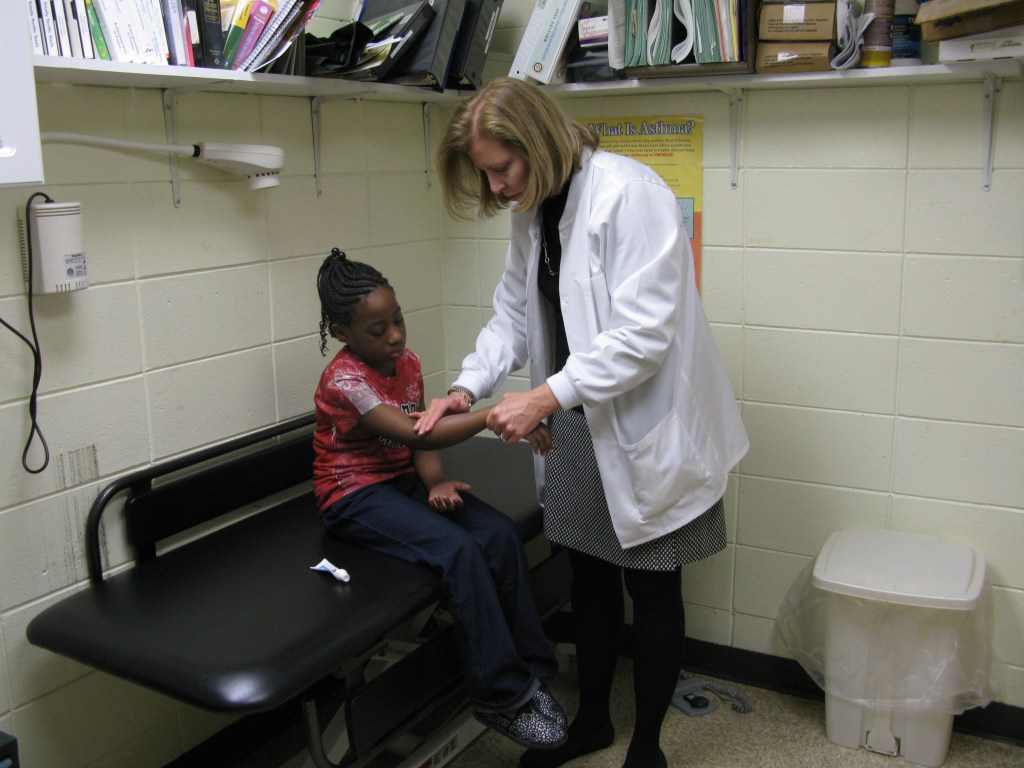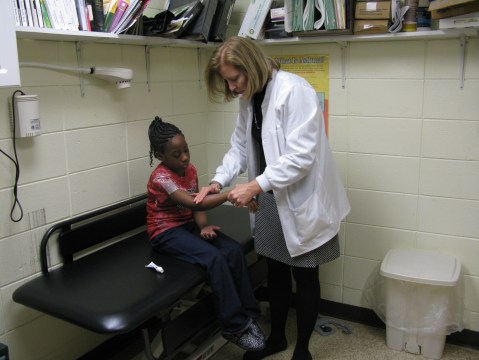Sally Boswell is the first person many low-income families in Greene County call when their child gets sick.
She hears about everything from acute ear infections to chronic conditions such as diabetes. Boswell helps parents, grandparents or guardians decide whether their child needs to see a doctor.
She is the only school nurse for the county’s 2,300 public school students. Despite the long economic downturn and resulting budget cuts, she has stuck with her passion for nursing.
Thanks to Lake Oconee, built in 1979, historically rural Greene County has attracted tourists and some very affluent residents in recent decades. Today it is listed as one of the wealthier counties in the state, with a median income of about $42,500. But poverty remains, and the number of Boswell’s students who are on Medicaid or are uninsured is high.
School funding for nurses and health care workers in Georgia varies by locale. Georgina Howard, director of the School Health Nurse Program at the Georgia Department of Education, says, “In Georgia, we’ve made some progress, but we aren’t fully staffed. It’s left up to the district how they want to do their staffing.”
The current recommendation from the National Association for School Nurses is to have 1 nurse per 750 students. Georgia’s 2,264 public schools serve 1.7 million students, so the recommended number of nurses for the state is 2,267.
But as of October 2014, there were only 1,555 licensed nurses who work in the state’s schools, Howard said. That leaves a shortage of more than 700.
Problems to confront
In neighboring Morgan County, with a median income at about $47,700, there are four nurses for about 3,200 students. “Morgan County has a school nurse at every school; primary, elementary, middle, and high school,” says Leah Ainslie, who worked in Greene County before she became the nurse manager for the local public health department in Morgan.
“[The] purpose of the school nurse is to keep children well, so the children can learn. If you don’t have anyone there to do that, then the kids aren’t learning,’’ says Ainslie.
Being the only school nurse in Greene County, Boswell barely has time to drive 10 minutes between the county’s one pre-school, two elementary schools, one middle school and one high school. The constantly shifting medical needs of students dictate what she does from one day to the next.
“When I started, we had four registered nurses and we ran a program, a true comprehensive nursing program,’’ Boswell says. “We did things like CPR classes for the bus drivers, we were able to do certain programs for not just the students, but for the faculty.”
Now, her attention is solely focused on the health of the students. In early February, the hot spot was Union Point STEAM Academy, a K-7 elementary school that focuses on science, technology, engineering, the arts and mathematics.
“I’ve got little kindergartners who are horrible asthmatics, and all of the diabetics at the elementary level are here,” Boswell says. “I have to be here to do insulin every day.”
Every day is different, but busy
Between administering breathing treatments and monitoring insulin levels, Boswell uses her qualifications as a pediatric nurse practitioner. She catheterizes a wheelchair-bound student, diagnoses an ear infection in another student, and lines up a doctor’s appointment for a third.
Boswell’s job has become much more than keeping kids well.
When a family member can’t come to pick up a sick child, she will even give the youngster a ride home (with parental permission, of course).
On a recent morning at 8:30, students swarmed in and out of her small office. One child’s arms were covered with what appeared to be insect bites, and an itchy and swollen rash was forming. Another was reporting for his asthma inhaler treatment, and two hovered over a single toilet for fear they were going to vomit.
“I am certainly the child’s advocate” on medical issues, says Boswell. “With 2,300 students and knowing their families, and where they come from . . . I think that I help the continuity of care.”
Ansley Stewart is pursuing her master’s degree in journalism at the University of Georgia. She is a freelance writer, musician, and also works full time at UGA.




